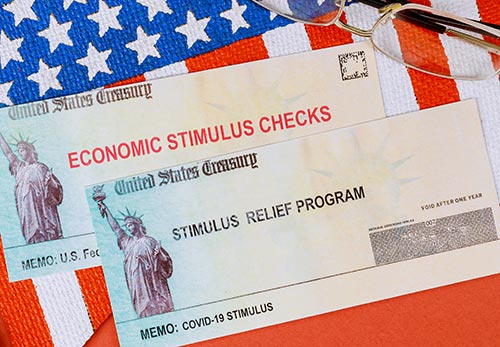[vc_row][vc_column width=”3/4″][vc_column_text]
Understanding What the New Coronavirus Relief Package Means for You
 The Coronavirus Aid, Relief, and Economic Security (CARES) Act was passed on March 25, 2020 in an effort to provide fast and direct relief from the devastating effect of the coronavirus pandemic. It was considered the largest economic relief plan to date so far in U.S. history and included $2.2 trillion in COVID-19 relief. This relief provided payments to qualifying households of up to $1,200 per adult and $500 per child in addition to a number of benefits for the unemployed, small businesses, renters, and more. Unfortunately, the pandemic has continued to uproot lives and over 10 million Americans remain unemployed and are struggling to pay their bills and feed their families. With failing efforts to “flatten the curve” individuals and businesses are doing everything they can to stay afloat. However, with the cessation of the CARES Act, many have found themselves without any options.
The Coronavirus Aid, Relief, and Economic Security (CARES) Act was passed on March 25, 2020 in an effort to provide fast and direct relief from the devastating effect of the coronavirus pandemic. It was considered the largest economic relief plan to date so far in U.S. history and included $2.2 trillion in COVID-19 relief. This relief provided payments to qualifying households of up to $1,200 per adult and $500 per child in addition to a number of benefits for the unemployed, small businesses, renters, and more. Unfortunately, the pandemic has continued to uproot lives and over 10 million Americans remain unemployed and are struggling to pay their bills and feed their families. With failing efforts to “flatten the curve” individuals and businesses are doing everything they can to stay afloat. However, with the cessation of the CARES Act, many have found themselves without any options.
In an effort to continue supporting those affected by COVID-19, the Coronavirus Response and Relief Supplemental Appropriations (Consolidated Appropriations) Act of 2021 was passed. Signed into law on December 27, 2020, this bill aims to provide continued relief through the form of a second stimulus check for individuals and families alongside increased options for loans for businesses across the United States. It aims on expanding the parameters of the CARES Act through an additional $900 billion relief plan. While all of this sounds promising, eligibility differs based on earning and household. For a better idea of what’s to come, here’s some information to understand what the new coronavirus relief package means for you.
Understanding the COVID-19 Legislation
The way that money from the COVID-19 relief is dispersed depends on phases and whether or not you’re an individual, family, or business. There are three different phases included in this legislation—Phase 1, 2, and 3. Phase 3.5, the Paycheck Protection Program and Health Care Enhancement Act is considered an extension of Phase 3.
Phase 1 (Coronavirus Preparedness and Response Supplemental Appropriations Act, 2020) provided funding for vaccine development, solidified eligibility for small business loans, and supported teleconferences for Medicare recipients. Phase 2 (Families First Coronavirus Response Act) extended certain provisions for paid sick leave, allowed for free coronavirus testing, improved the food assistance and unemployment benefits, and required that employers provided added security for healthcare workers. Phase 3 (CARES Act) provided stimulus checks to eligible taxpayers and expanded unemployment benefits even further. Phase 3.5 (Paycheck Protection Program and Health Care Enhancement Act) was enacted to serve as interim funding for Phase 3.
The new coronavirus relief package is primarily focused at expanding parts of Phase 3 such as the Paycheck Protection Program, economic stimulus relief, and certain protections that had expired or were set to expire in 2020.
Economic Stimulus Payments for Taxpayers
For those who meet the eligible criteria, a second wave of stimulus payments is on its way from the Consolidated Appropriations Act of 2021. This will include direct payments of $600 to an individual, or $1,200 for joint taxpayers. It also covers an additional $600 for each child under the age of 17 in a household. Similar to the first round of stimulus checks, taxpayers do not need to take any action to receive their payment. You will be issued the relief based on your 2019 tax return and can expect to receive your payment either through direct deposit or in the form of a check. If you do not have direct deposit currently set up, you may need to wait a little longer before you receive your check in the mail. To learn more about your payment status, visit the IRS Get My Payment page.
If you make an adjusted gross income (AGI) of over $75,000 a year ($150,000 for joint taxpayers), you may not be eligible to receive the full $600 stimulus check. Your eligible amount will decrease in proportion to the increased income that you make. The payments drop by $5 for every $100 above the $750,000 income limit. If you make an AGI over $87,000, you will not receive a stimulus check.
Unfortunately, at the beginning of the Consolidated Appropriations Act, there was an error at the IRS that sent payments to the wrong accounts. Because of this, your payment may be delayed or arrive later than expected. If you have questions, visit the IRS resource page to stay updated on your payment status.
Extended Unemployment
Another key piece of the Consolidated Appropriations Act is the extensions of unemployment benefits. Under the CARES Act, unemployment benefits retired July 31, 2020. After expiration, those who are unemployed stopped receiving the additional $600 in supplemental compensation. With COVID-19 still leaving millions of Americans out of work, there was a lot of stress and anxiety about this change. With the extension, unemployment payments will increase again by $300 per week and these benefits will continue until March 14, 2021.
This extension includes the Pandemic Unemployment Assistance (PUA), which now covers those who are self-employed, freelancing, or carrying out some sort of side work. Eligibility varies, so make sure that you fully understand what you need to do if you’re unemployed or have lost a significant portion of your income due to COVID-19.
Extended Paycheck Protection Program for Small Businesses
Small business owners have been some of the hardest hit since the onset of COVID-19. With government mandated shutdowns, it became difficult, if not impossible, to stay in business. The new coronavirus relief package will provide more than $284 billion for first and second forgivable coronavirus relief loans to small businesses. It extends the Paycheck Protection Program (PPP) loans to give additional funding for those businesses who didn’t receive it, broadens the business expenses that can be forgiven, and expands eligibility to different types of businesses and industries previously omitted. $15 billion is said to be reserved for live venues, independent movie theaters, and cultural institutions and $10 billion for childcare centers.
If you already have a PPP loan, you may be eligible to receive a second one called a “PPP second draw.” If you never obtained a PPP loan, your eligibility may have changed with the expansion of the CARES Act. Unfortunately, due to this expansion, things get a bit more complicated. Make sure that you review everything in the Small Business Administration (SBA) guidelines to better understand your eligibility and how to go about applying for a PPP loan.
For those small businesses who obtain a PPP loan, make sure that you’re using it to cover eligible costs. These costs have been extended since the origination of the CARES Act and now include certain operation expenditures, property damage repairs that are related to the public disturbances throughout 2020, personal protective equipment, and a variety of insurance benefits. In an effort to prepare for 2021, it’s important that you’re set up for success. Make sure that you know your rights and understand exactly what needs to be done to create a fulfilling future.
To help you better understand your eligibility, talk with a certified public accountant from Del Real Tax Group today. We strive to help businesses use timely and accurate accounting information and tax planning to make informed decisions about their businesses that will help them grow and achieve their goals. If you’ve been affected by COVID-19 and are interested in learning more about how the Paycheck Protection Program (PPP) can help you during the coronavirus crisis, contact us today at 708-788-0082.[/vc_column_text][/vc_column][vc_column width=”1/4″][vc_single_image image=”238″ img_size=”275×270″][vc_raw_html]JTNDc3Ryb25nJTNFQ2hpY2FnbyUyMENQQSUyQyUyME1hcmliZWwlMjBEZWwlMjBSZWFsJTNDJTJGc3Ryb25nJTNF[/vc_raw_html][vc_text_separator title=”Services:” color=”juicy_pink” style=”double”][vc_accordion active_tab=”1″][vc_accordion_tab title=”Tax Accounting”][vc_raw_html]JTNDcCUzRVdlJTIwcGVyZm9ybSUyMHRheCUyMFBsYW5uaW5nJTIwYW5kJTIwdGF4JTIwY29uc3VsdGluZyUyMHllYXIlMjByb3VuZC4lMjBXZSUyMHVuZGVyc3RhbmQlMjB0aGF0JTIwcHJlcGFyaW5nJTIweW91ciUyMG93biUyMGluY29tZSUyMHRheCUyMHJldHVybiUyMGNhbiUyMGJlJTIwYSUyMHRhc2slMjB0aGF0JTIwbGVhdmVzJTIweW91JTIwd2l0aCUyMG1vcmUlMjBxdWVzdGlvbnMlMjB0aGFuJTIwYW5zd2Vycy4lMjAlM0NhJTIwdGl0bGUlM0QlMjJUYXglMjBBY2NvdW50aW5nJTIwU2VydmljZXMlMjIlMjBocmVmJTNEJTIyaHR0cHMlM0ElMkYlMkZ3d3cuZGVscmVhbHRheC5jb20lMkZ0YXgtYWNjb3VudGluZy1zZXJ2aWNlcyUyRiUyMiUzRVZpZXclMjBNb3JlJTNDJTJGYSUzRSUzQyUyRnAlM0U=[/vc_raw_html][/vc_accordion_tab][vc_accordion_tab title=”Small Business Accounting & Bookkeeping”][vc_raw_html]JTNDcCUzRUxvb2tpbmclMjBmb3IlMjBhJTIwQ1BBJTIwdG8lMjBwZXJmb3JtJTIweW91ciUyMGJvb2trZWVwaW5nJTIwb3IlMjBhbiUyMGFjY291bnRhbnQlMjBmb3IlMjB5b3VyJTIwc21hbGwlMjBidXNpbmVzcyUzRiUyMERlbCUyMFJlYWwlMjBUYXglMjBoYXMlMjBiZWVuJTIwd29ya2luZyUyMHdpdGglMjBzbWFsbCUyMGJ1c2luZXNzZXMlMjBhbmQlMjBpbmRpdmlkdWFscyUyMGxvY2F0ZWQlMjBhcm91bmQlMjBDaGljYWdvJTIwZm9yJTIwbWFueSUyMHllYXJzJTIwcGVyZm9ybWluZyUyMG1hbnklMjBhY2NvdW50aW5nJTIwdGFza3MlMjB0aGF0JTIwY2FuJTIwYmUlMjBoYXJkJTIwZm9yJTIwc21hbGwlMjBidXNpbmVzcyUyMG93bmVycyUyMGFuZCUyMGluZGl2aWR1YWxzJTIwdG8lMjB1bmRlcnN0YW5kLiUyMCUzQ2ElMjB0aXRsZSUzRCUyMkluZGl2aWR1YWwlMjBhbmQlMjBTbWFsbCUyMGJ1c2luZXNzJTIwQWNjb3VudGluZyUyMFNlcnZpY2VzJTIyJTIwaHJlZiUzRCUyMmh0dHBzJTNBJTJGJTJGd3d3LmRlbHJlYWx0YXguY29tJTJGc21hbGwtYnVzaW5lc3MtYWNjb3VudGluZy1ib29ra2VlcGluZy1zZXJ2aWNlcyUyRiUyMiUzRVZpZXclMjBtb3JlLiUzQyUyRmElM0UlM0MlMkZwJTNF[/vc_raw_html][/vc_accordion_tab][vc_accordion_tab title=”Payroll Accounting”][vc_raw_html]JTNDcCUzRURlbCUyMFJlYWwlMjBUYXglMjBHcm91cCUyMG9mZmVycyUyMHBheXJvbGwlMjBhY2NvdW50aW5nJTIwc29sdXRpb25zJTIwdGhhdCUyMG1lZXQlMjB5b3VyJTIwYnVzaW5lc3MlRTIlODAlOTlzJTIwbmVlZHMlMjBhbmQlMjBlbmFibGUlMjB5b3UlMjB0byUyMHNwZW5kJTIwdGltZSUyMGRvaW5nJTIwd2hhdCUyMHlvdSUyMGRvJTIwYmVzdCUyMCVFMiU4MCU5MyUyMHJ1bm5pbmclMjB5b3VyJTIwY29tcGFueS4lMjAlM0NhJTIwdGl0bGUlM0QlMjJQYXlyb2xsJTIwYWNjb3VudGluZyUyMHNlcnZpY2VzJTIyJTIwaHJlZiUzRCUyMmh0dHBzJTNBJTJGJTJGd3d3LmRlbHJlYWx0YXguY29tJTJGcGF5cm9sbC1hY2NvdW50aW5nLXNlcnZpY2VzJTJGJTIyJTNFVmlldyUyMG1vcmUuJTNDJTJGYSUzRSUzQyUyRnAlM0U=[/vc_raw_html][/vc_accordion_tab][vc_accordion_tab title=”Entity Selection & Restructuring”][vc_raw_html]JTNDcCUzRUNob29zaW5nJTIwdGhlJTIwcmlnaHQlMjBjb21wYW55JTIwc3RydWN0dXJlJTIwaXMlMjBjcnVjaWFsJTIwaW4lMjBwbGFubmluZyUyMGZvciUyMHRoZSUyMHN1Y2Nlc3NmdWwlMjBvcGVyYXRpb24lMjBvZiUyMGFueSUyMGJ1c2luZXNzLiUyMFRoZXNlJTIwZGVjaXNpb25zJTIwY2FuJTIwYWZmZWN0JTIwYSUyMGJyb2FkJTIwcmFuZ2UlMjBvZiUyMGlzc3VlcyUyQyUyMGZyb20lMjBlcXVpdHklMjBhcnJhbmdlbWVudHMlMjBhbmQlMjB0YXglMjBhZHZhbnRhZ2VzJTIwdG8lMjBsb25nLXRlcm0lMjBmaW5hbmNpbmclMjBhbmQlMjBzdWNjZXNzaW9uJTIwb2YlMjBvd25lcnNoaXAuJTIwRGVsJTIwUmVhbCUyMFRheCUyMEdyb3VwJTIwY2FuJTIwaGVscC4lMjAlM0NhJTIwdGl0bGUlM0QlMjJjb21wYW55JTIwcmVzdHJ1Y3R1cmluZyUyMHNlcnZpY2VzJTIyJTIwaHJlZiUzRCUyMmh0dHBzJTNBJTJGJTJGd3d3LmRlbHJlYWx0YXguY29tJTJGZW50aXR5LXNlbGVjdGlvbi1hbmQtcmVzdHJ1Y3R1cmluZyUyRiUyMiUzRVZpZXclMjBtb3JlLiUzQyUyRmElM0UlM0MlMkZwJTNF[/vc_raw_html][/vc_accordion_tab][vc_accordion_tab title=”IRS Representation”][vc_raw_html]JTNDcCUzRURlbCUyMFJlYWwlMjBUYXglMjBHcm91cCUyMGhhbmRsZXMlMjBJUlMlMjBhdWRpdCUyMHJlcHJlc2VudGF0aW9uJTIwZm9yJTIwYnVzaW5lc3NlcyUyMGxvY2F0ZWQlMjB0aHJvdWdob3V0JTIwQ2hpY2FnbyUyMHNvJTIweW91JTIwbmVlZCUyMG5vdCUyMHRha2UlMjB0aW1lJTIwb2ZmJTIwb2YlMjB5b3VyJTIwYnVzaW5lc3MlMjBvciUyMGpvYiUyMHRvJTIwaGFuZGxlJTIwdGhlJTIwYnVyZWF1Y3JhY3klMjBhbmQlMjBwYXBlcndvcmslMjBvZiUyMGFuJTIwSVJTJTIwYXVkaXQuJTIwJTNDYSUyMHRpdGxlJTNEJTIySVJTJTIwYXVkaXQlMjByZXByZXNlbnRhdGlvbiUyMGNvbXBhbnklMjIlMjBocmVmJTNEJTIyaHR0cHMlM0ElMkYlMkZ3d3cuZGVscmVhbHRheC5jb20lMkZpcnMtcmVwcmVzZW50YXRpb24lMkYlMjIlM0VWaWV3JTIwbW9yZS4lM0MlMkZhJTNFJTNDJTJGcCUzRQ==[/vc_raw_html][/vc_accordion_tab][/vc_accordion][vc_raw_html]JTNDYnIlMkYlM0UlMEElM0NiciUyRiUzRQ==[/vc_raw_html][vc_text_separator title=”Sign up for our Newsletter:” color=”juicy_pink” style=”double”][dt_contact_form fields=”name,email,message” required=”name,email,message” button_size=”small”][/vc_column][/vc_row]

